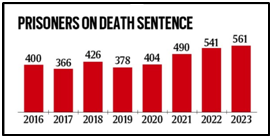INDIA’S BURGEONING DEATH PENALTY CRISIS
Relevance: GS2 – Government Policies and Interventions for Development in various sectors and Issues arising out of their Design and Implementation.
Why in the News?
- India’s death row population reached its highest-ever numbers since 2004, with 561 prisoners at the end of 2023.
- The Supreme Court of India acquitted approximately 55% of the death row prisoners it heard cases for in 2023, amounting to six prisoners.
- This trend is unprecedented and noteworthy, especially considering the significant number of acquittals.
- The Supreme Court’s initiative in September 2022 to convene a Constitution Bench to reform death penalty sentencing adds context to this development.
Data on Sentencing
- Despite the Supreme Court’s efforts to reform sentencing in the Manoj vs The State Of Madhya Pradesh case (May 2022)
- Project 39A’s 2023 annual statistics, trial courts continued to impose 86.96% of death sentences in 2023 without mandated information about the accused from the Manoj case.
- The lack of impact for two consecutive years indicates the failure of the Court’s attempts to influence trial court practices.
- Reluctance in Confirming Death Sentences:
- In 2023, High Courts displayed hesitancy in confirming death sentences, with only one such sentence confirmed, contrasting sharply with trial court impositions.
- The Death Penalty India Report (2016) revealed that, historically, only 4.9% of death sentences from trial courts (2000-15) were confirmed at the appellate level.
- Over the years, the Supreme Court has often upheld convictions while commuting death sentences to life imprisonment.
Dominance of Acquittals and Systemic Failures
- In 2023, the Supreme Court’s decisions saw a notable increase in acquittals, shedding light on systemic failures within the criminal justice system.
- Acquittals were driven by issues such as fabricated evidence, manipulated first information reports, potential tampering of forensic evidence, and dubious recoveries of incriminating evidence by the police.
- The prevalence of acquittals in the Court’s death penalty decisions in 2023 points to a pressing need to address systemic flaws.
Lack of Systemic Recognition in Acquittal Decisions:
- The Supreme Court, while acquitting death row prisoners, has provided case-specific reprimands without acknowledging the systemic problems in administering the death penalty.
- In contrast, the Court has been more willing to recognize systemic concerns related to death penalty sentencing, as evidenced by the decision in September 2022 to refer crucial issues to a Constitution Bench.
- Urgent Need to Recognize High Chances of Error
- The growing number of acquittals by the Supreme Court in death penalty cases in 2023 emphasizes the urgent need to recognize the high likelihood of errors in the criminal justice system.
- Repeated instances of acquittals from death row should compel a reconsideration of the risks inherent in the current legal framework.
Conditions Faced by Death Row Prisoners
- Death row prisoners endure constant distress and fear of execution, often facing violence, ridicule, and humiliation within prisons.
- Prison policies segregate them from work, education, and leisure, depriving them of coping mechanisms in dehumanizing circumstances.
- The psychological impact of the death row experience persists long after acquittal or commutation.
Increasing Death Row Population
- The death row population continues to rise annually due to the exaggerated and unjustifiable imposition of the death penalty by trial courts.
- Project 39A’s report indicates a 15% decrease in the High Court’s case disposal rate, worsening an existing crisis.
- Many death row prisoners endure the horrors of their situation unnecessarily before acquittal or commutation, while others may face tragic outcomes like suicide.
Need for Reform in Justice System
- The Supreme Court’s initiatives, such as convening a Constitution Bench, may not effectively address the death penalty crisis.
- Death penalty sentencing reforms by the Supreme Court have not translated to changes in trial court practices, highlighting the futility of such efforts.
- Project 39A’s 2023 report underscores a disconnect between the narrow focus of the Court on sentencing questions and the broader crisis spanning the entire criminal process in death penalty cases.
- The Supreme Court’s actions may be perceived as inadequate and too late to address the systemic issues plaguing the administration of death penalty in India.
Source: https://www.thehindu.com/opinion/op-ed/indias-burgeoning-death-penalty-crisis/article67904333.ece
Mains question
In light of rising death row populations and systemic failures, discuss the efficacy of Supreme Court initiatives in addressing the death penalty crisis in India. (250 words)




